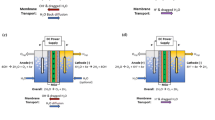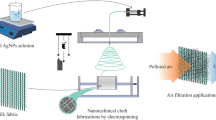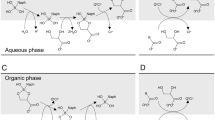Abstract
This work is aimed at obtaining a membrane material that is resistant to the formation of a precipitate on the surface upon contact with an ABE fermentation mixture and possesses a good separating ability during the pervaporation isolation of n-butanol from a water–alcohol mixture. In this regard, this work for the first time proposes creating pervaporation membranes based on polymethyltrifluoroethylacrylatesiloxane (F3-Acr) as well as a copolymer of polydecylmethylsiloxane and polymethyltrifluoroethylacrylatesiloxane (C10–F3-Acr). The structure and sorption properties of the developed membrane materials for n-butanol, ethanol, and acetone are studied in comparison with polydecylmethylsiloxane (C10). It should be noted that the highest sorption of n-butanol is characteristic for C10–F3-Acr (0.46 g/g). The change in the surface properties is assessed by the value of the contact angle and elemental composition of the surface before and after exposure for 1 month in a fermentation medium. The transport and separation properties of the synthesized membrane materials are studied in the vacuum pervaporation mode during the separation of a model ABE fermentation mixture. It is shown that introducing a fluorine-containing substituent into the side chain of polysiloxane makes it possible to increase the hydrophilicity of the polymer: the water flow for F3-Acr is 0.7 × 10−6 kg m m−2 h−1, which is almost threefold higher when compared to C10. A positive effect of the combination of C10 and F3-Acr groups in polysiloxane is worth noting. Thus, with an increase in the total flow by 60% when compared to a C10 membrane, the values of the separation factor for n-butanol, acetone, and ethanol are 40.5, 32.7, and 4.3 and increase by 6, 15, and 12%, respectively, when compared to a C10 membrane. For a C10–F3-Acr membrane, the pervaporation separation indices for n-butanol, acetone, and ethanol are 136, 109, and 11, respectively. Therefore, this membrane is twice as efficient as C10. Taking into account the absence of detectable contamination of the surface of the membrane material with fermentation products, one can note a high potential of a C10–F3-Acr membrane for the task of isolating alcohols from an ABE fermentation mixture.




Similar content being viewed by others
REFERENCES
P. Zheng, C. Li, N. Wang, J. Li, and Q. An, Chinese J. Chem. Eng. 27, 1296 (2019).
Y. K. Oh, K. R. Hwang, C. Kim, J. R. Kim, and J. S. Lee, Biores. Technol. 257, 320 (2018).
P. Dürre, J. Health Care Nutr. Technol. 2, 1525 (2007).
V. García, J. Päkkilä, H. Ojamo, E. Muurinen, and R. L. Keiski, Renew. Sust. Energ. Rev. 15, 964 (2011).
E. M. Green, Curr. Opin. Biotechnol. 22, 337 (2011).
P. P. Peralta-Yahya and J. D. Keasling, Biotechnology J. 5, 147 (2010).
G. Liu, W. Wei, H. Wu, X. Dong, M. Jiang, and W. Jin, J. Membr. Sci. 373, 121 (2011).
A. Kujawska, J. Kujawski, M. Bryjak, and W. Kujawski, Renew. Sustain. Energy Rev. 48, 648 (2015).
A. Pulyalina, G. Polotskaya, M. Goikhman, I. Podeshvo, B. Chernitsa, V. Kocherbitov, and A. Toikka, Sci. Rep. 7, 1 (2017).
B. Van der Bruggen and P. Luis, Curr. Opin. Chem. Eng. 4, 47 (2014).
A. A. Atlaskin, A. N. Petukhov, N. R. Yanbikov, M. E. Salnikova, M. S. Sergeeva, V. M. Vorotyntsev, and I. V. Vorotyntsev, Chem. Proc. Eng. 323 (2018).
K. V. Otvagina, A. V. Penkova, M. E. Dmitrenko, A. I. Kuzminova, T. S. Sazanova, A. V. Vorotyntsev, and I. V. Vorotyntsev, Membranes 9, 38 (2019).
G. Liu, W. Wei, and W. Jin, ACS Sustain. Chem. Eng. 2, 546 (2014).
A. Rozicka, J. Niemisto, R. L. Keiski, and W. Kujawski, J. Membr. Sci. 453, 108 (2014).
A. Rom and A. Friedl, Sep. Purif. Technol. 170, 40 (2016).
A. Kujawska, K. Knozowska, J. Kujawa, G. Li, and W. Kujawski, Sep. Purif. Technol. 234, 116092 (2020).
I. L. Borisov, N. V. Ushakov, V. V. Volkov, and E. Sh. Finkel’shtein, Pet. Chem. 56, 798 (2016).
M. Bennett, B. J. Brisdon, R. England, and R. W. Field, J. Membr. Sci. 137, 63 (1997).
E. A. Grushevenko, I. A. Podtynnikov, and I. L. Borisov, Russ. J. Appl. Chem. 92, 1593 (2019).
I. Borisov, I. Podtynnikov, E. Grushevenko, O. Scharova, T. Anokhina, S. Makaev, A. Volkov, and V. Volkov, Polymers 12, 1213 (2020).
A. V. Penkova, S. F. Acquah, M. P. Sokolova, M. E. Dmitrenko, and A. M. Toikka, J. Membr. Sci. 491, 22 (2015).
G. A. Polotskaya, A. Y. Pulyalina, V. A. Rostovtseva, A. M. Toikka, N. N. Saprykina, and L. V. Vinogradova, Polym. Int. 65, 407 (2016).
Z. Jia and G. Wu, Microporous Mesoporous Mater. 235, 151 (2016).
G. Liu, V. Chernikova, Y. Liu, K. Zhang, Y. Belmabkhout, O. Shekhah, C. Zhang, S. Yi, M. Eddaoudi, and W. J. Koros, Nat. Mater. 17, 283 (2018).
P. Yu. Apel, S. Velizarov, A. V. Volkov, T. V. Eliseeva, V. V. Nikonenko, A. V. Parshina, N. D. Pismenskaya, K. I. Popov, and A. B. Yaroslavtsev, Membr. Membr. Tekhnol. 4, 69 (2022).
V. Volkov, I. Borisov, G. Golubev, V. Vasilevsky, D. Matveev, G. Bondarenko, and A. Volkov, J. Chem. Technol. Biotechnol. 9, 40 (2020).
A. G. Fadeev, M. M. Meagher, S. S. Kelley, and V. V. Volkov, J. Membr. Sci. 173, 133 (2000).
N. Qureshi and H. P. Blaschek, Biotechnol. Progr. 15, 594 (1999).
T. N. Rokhmanka, E. A. Grushevenko, O. V. Arapova, G. N. Bondarenko, G. S. Golubev, I. L. Borisov, and A. V. Volkov, Appl. Sci. 13, 3827 (2023).
K. Knozowska, A. Kujawska, J. Kujawa, W. Kujawski, M. Bryjak, E. Chrzanowska, and J. K. Kujawski, Sep. Purif. Technol. 188, 512 (2017).
A. V. Yakovlev, M. G. Shalygin, S. M. Matson, V. S. Khotimskiy, and V. V. Teplyakov, J. Membr. Sci. 434, 99 (2013).
M. G. Shalygin, A. A. Kozlova, and V. V. Teplyakov, Membr. Membr. Technol. 4, 258 (2022).
Z. Chu and S. Seeger, Chem. Soc. Rev. 43, 2784 (2014).
A. Tuteja, W. Choi, M. Ma, J. M. Mabry, S. A. Mazzella, G. C. Rutledge, G. H. McKinley, and R. E. Cohen, Science 308, 1618 (2007).
X. Lu, Y. Peng, L. Ge, R. Lin, Z. Zhu, and S. Liu, J. Membr. Sci. 505, 61 (2016).
R. Zheng, Y. Chen, J. Wang, J. Song, X.-M. Li, and T. He, J. Membr. Sci. 555, 197 (2018).
H. Zhu, X. Li, Y. Pan, G. Liu, H. Wu, M. Jiang, and W. Jin, J. Membr. Sci. 609, 118225 (2020).
I. L. Borisov, E. A. Grushevenko, T. S. Anokhina, D. S. Bakhtin, I. S. Levin, G. N. Bondarenko, V. V. Volkov, and A. V. Volkov, Mater. Today Chem. 22, 100598 (2021).
S. Darvishmanesh, J. Degreve, and B. Van der Bruggen, Chem. Eng. Sci. 64, 3914 (2009).
A. A. Yushkin, T. S. Anokhina, S. D. Bazhenov, I. L. Borisov, P. M. Budd, and A. V. Volkov, Pet. Chem. 58, 1154 (2018).
N. Kang, Z. Du, H. Li, and C. Zhang, J. Appl. Polym. Sci. 124, 4915 (2011).
S. A. Stern, V. M. Shah, and B. J. Hardy, J. Polym. Sci. B 25, 1263 (1987).
ACKNOWLEDGMENTS
This work was performed using the equipment of the Shared Research Center Analytical Center of Deep Oil Processing and Petrochemistry, Russian Academy of Sciences. The authors are grateful to M.P. Filatova for executing NMR spectroscopy and to G.A. Shandryuk for executing DSC.
Funding
This study was financially supported by a grant from the Russian Science Foundation (no. 22-79-10332, https://rscf.ru/project/22-79-10332/).
Author information
Authors and Affiliations
Corresponding author
Ethics declarations
The authors declare that they have no conflicts of interest.
Additional information
Translated by E. Boltukhina
Rights and permissions
About this article
Cite this article
Grushevenko, E.A., Rokhmanka, T.N., Balynin, A.V. et al. Trifluoroethyl Acrylate-Substituted Polymethylsiloxane—a Promising Membrane Material for Separating an ABE Fermentation Mixture. Membr. Membr. Technol. 5, 394–404 (2023). https://doi.org/10.1134/S2517751623060057
Received:
Revised:
Accepted:
Published:
Issue Date:
DOI: https://doi.org/10.1134/S2517751623060057




